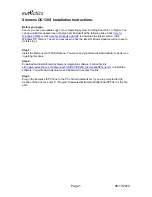
A V G 9 .0 A nti- V irus Bus ines s E dition © 2 0 0 9 C opyright A V G T ec hnologies C Z, s .r.o. A ll rights res erved.
2 2 9
14. Updates
14.1. General Information
AVG offers two update levels to select from:
·
Definitions update
contains changes necessary for reliable anti-virus, anti-
spam and anti-malware protection. Typically, it does not include any changes to
the code and updates only the definition database. This update should be
applied as soon as it is available.
·
Program update
contains various program changes, fixes and improvements.
When scheduling an update, it is possible to select which priority level should be
downloaded and applied.
You can distinguish between two types of update:
·
On demand update
is an immediate AVG update that can be performed any
time the need arises.
·
Scheduled update
- within AVG it is also possible to pre-set an update plan.
The planned update is then performed periodically according to the setup
configuration. Whenever new update files are present on the specified location,
they are downloaded either directly from the Internet, or from the network
directory. When no newer updates are available, nothing happens.
Note:
If a time coincidence of a scheduled program update and scheduled scan
occurs, the update process is of higher priority and the scan will get interrupted.
14.2. Update within the Local Network
AVG stations can perform an update directly from the AVG Technologies web servers.
Also, it is possible to download the update file onto a LAN server, and configure the
AVG stations for local update.
For smaller networks (20-25 stations typically) it is recommended to update directly
from the internet. AVG update files are designed so that always the smallest available
required files are downloaded.
If the network consists of more than 50 stations, it is better to maintain mirroring of all
the available update files within the local network. All the update files (that could be
used for all the previous AVG versions update) must be downloaded this way to allow
AVG stations to use the current file to perform the program/virus database update.
Generally, there are two options of update files local mirroring. The recommended
option is using the UpdateProxy role, that can be deployed also on multiple servers.














































